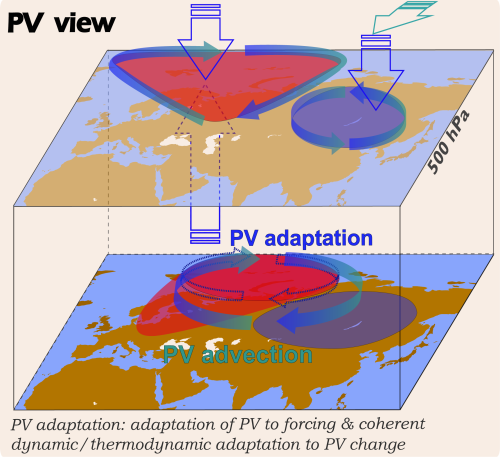JC: A Potential Vorticity View on the Linkage between Arctic Warming and Eurasian Climate Change
Date:2020-07-09
Against the overall global warming background, warming rate, if not cooling, varies substantially across different regions. The amplified wintertime warming in the Arctic during the past several decades has drawn worldwide attention. In contrast, the adjacent Eurasia continent experienced a cooling change in the winter. The underlying dynamic mechanisms of such warming/cooling contrast are paramount in understanding regional climate change.
A recent work published in Journal of Climate sheds light on the dynamics concerning this warming/cooling contrast. This work reveals that the wintertime zonal asymmetric Arctic warming can regulate the Eurasian climate change through local potential vorticity (PV) generation and PV advection toward midlatitude.
The specific dynamic mechanisms summarized as follows (visualized in the schematic figure above). First, an anticyclonic circulation change over the Arctic is produced by a negative PV generated by the bottom stronger Arctic warming. Second, polar high-PV was advected to midlatitude on the eastern flank of the anticyclonic circulation due to the existence of climatological PV gradients. At the same time, the climatological westerlies blow the high-PV downstream. Thus, as a balanced result, both the circulation change and PV change extend to the midlatitude through horizontal PV advection and PV adaptation. Eventually, Eurasian cooling at the surface and in the lower troposphere is dominated by PV changes at the surface through PV adaptation. Meanwhile, enhanced Eurasian cooling in the middle troposphere is dominated by top-down influences of upper-level PV change through PV adaptation. Here, the upper-level PV changes are contributed by horizontal PV advection associated with Arctic warming. 
In another word, the spatial pattern and vertical structure of Arctic warming and climatological PV distribution are crucial factors that determine the linkages between midlatitude and Arctic.
"Our findings could be beneficial for both theoretical understanding and practical modeling. For example, attention should be paid to climatological PV distribution when performing emergent constraints on the climate model." said Dr. XIE Yongkun, the lead author from the Institute of Atmospheric Physics at Chinese Academy of Sciences.
This work is supported by the Priority Research Program of the Chinese Academy of Sciences (QYZDY-SSW- DQC018) and the National Natural Science Foundation of China (41730963).
Reference:
Yongkun XIE, Guoxiong WU*, Yimin LIU, Jianping HUANG, 2020: Eurasian Cooling Linked with Arctic Warming: Insights from PV Dynamics. Journal of Climate, 33, 2627–2644.
https://journals.ametsoc.org/jcli/article/33/7/2627/346409/Eurasian-Cooling-Linked-with-Arctic-Warming
Media contact: Ms. LIN Zheng, jennylin@mail.iap.ac.cn
